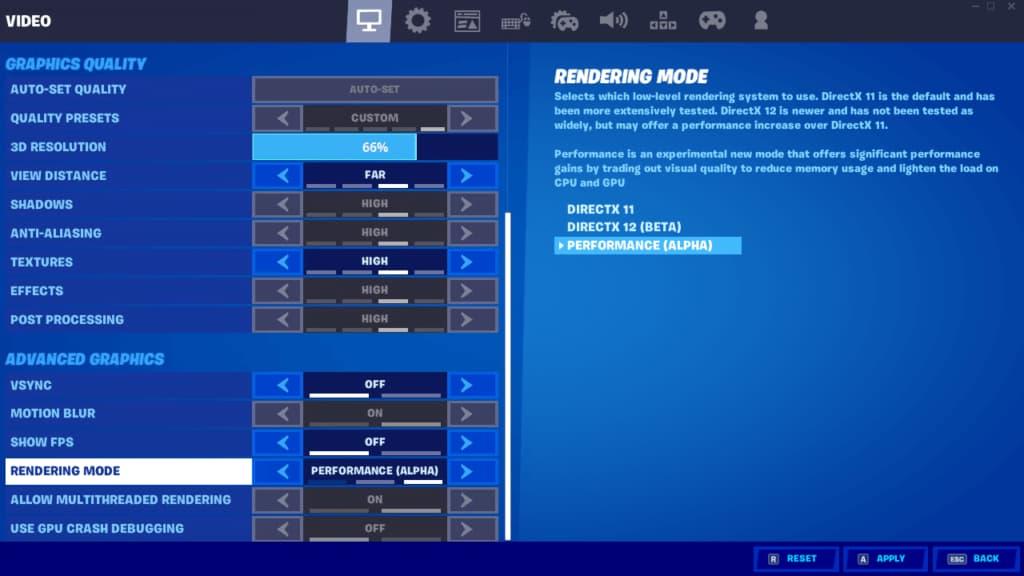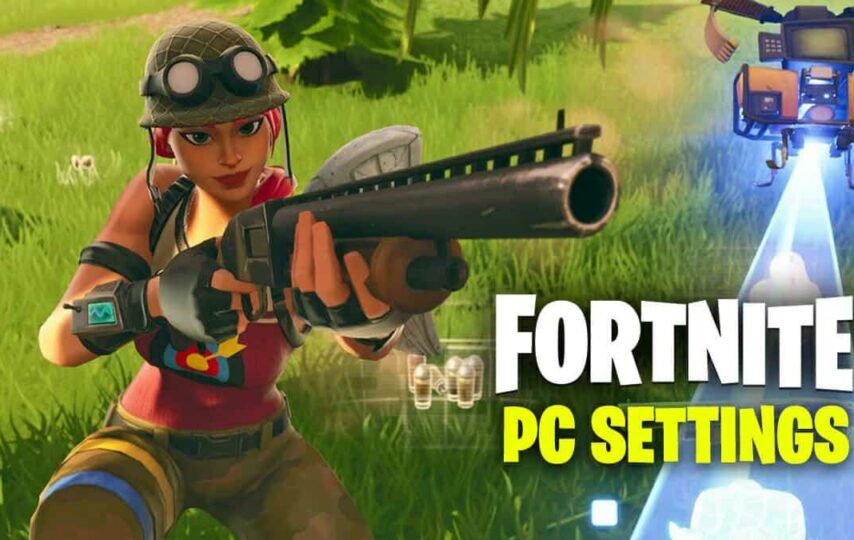Boosting your PC for Fortnite is crucial for smooth gaming. Note that glitches and frame drops kill the joy. So, the right settings matter big for in-game performance. Precision in adjusting these settings is also crucial to optimize your system’s capabilities and achieve a fluid gaming experience.
Note that your PC’s configurations directly affect how well you perform in your Fortnite matches. A deft hand, a keen eye for the minute adjustments, becomes the key, the open doorway to unlocking your system’s latent potential. Note that the best Fortnite settings will also ensure a smooth gaming experience.
What are the Best Fortnite Settings?
We experimented with Fortnite’s settings to discover the most optimized configurations for optimal performance and visual clarity. Given the competitive nature of the game, the primary aim in adjusting settings is to enhance speed without sacrificing visual quality to the extent that it becomes distracting. While there’s a degree of personal preference involved in in-game settings, I’ll also highlight a few preferences that I find indispensable or avoidable.

Image credit- EPIC GAMES
Window mode: Fullscreen
Resolution: Configure it to your monitor’s native resolution, likely 1920 x 1080 or 2560 x 1440.
VSync: Off
Frame rate limit: Unlimited, or align it with your monitor’s refresh rate.
Rendering mode: DirectX 12 or Performance
Anti-aliasing and super-resolution: FXAA
Temporal Super Resolution: N/A
3D resolution: 100%
View distance: Medium
Shadows: Off
Global Illumination: Off
Textures: Low
Effects: Low
Post-processing: Off
Hardware ray tracing: Off
Nvidia Reflex Low Latency: On + Boost in case you have an Nvidia GPU
DLSS: In case you process an Nvidia GPU
Finding the sweet spot for game performance and visual allure lies in the embrace of your monitor’s native resolution, that familiar territory marked by the digits 1920 x 1080 or 2560 x 1440. If you possess a 4K monitor, opting for lower resolutions might enhance performance, but the resulting blurriness from straying outside the native resolution isn’t recommended. Disable VSync to avoid input lag, unless you have Freesync or G-Sync on your monitor, in which case, utilizing these options is a preferable alternative. Adjust the frame rate to unlimited or match it with your monitor’s refresh rate, unless you intend to reduce the workload on your graphics chip.
If necessary, decrease it to the appropriate level. Opt for Rendering Mode DX12 if your graphics card is compatible, as it provides the optimal balance of performance and stability. Reserve Performance mode for significantly older PCs, as it makes the game playable but at a substantial visual sacrifice. While disabling anti-aliasing can boost performance, I prefer to keep it on to mitigate jagged edges in all the games I play, including Fortnite. TAA is also an option, though it tends to be more resource-intensive.
While these settings won’t provide a breathtaking visual experience, they maintain a good enough appearance without causing distractions. I adjusted View Distance to Medium to alleviate pop-in issues, but setting it to near has a negligible impact and can slightly improve performance. Keep all other settings off or low, unless you own an Nvidia graphics card; in that case, it’s advisable to enable Reflex with Boost and turn on DLSS if available, providing an additional performance boost at no extra cost.
What are the System Requirements for Fortnite?

Image credit- EPIC GAMES
Fortnite sets forth relatively higher system requirements compared to older esports titles like League of Legends or Rocket League, yet they remain modest enough for most PC gamers to meet the performance threshold for running the game.
Minimum system requirements:
CPU: Intel Core i3-3225 or newer
Memory: 8GB
Operating system: Windows 10 64-bit
Note that the minimum requirements don’t specify a dedicated graphics chip. Therefore, as long as your CPU is sufficiently recent to rival the 11-year-old Intel Core i3, your onboard graphics should suffice for a basic Fortnite gaming experience.
Recommended system requirements
Processor: Intel Core i5 7500U
RAM: 8GB
GPU: Nvidia GTX 960, AMD R9 280, or superior
OS: Windows 10 64-bit
The provided specifications establish a higher benchmark. However, they fall comfortably within the capabilities of the majority of contemporary gaming PCs. The recommended graphics card options have been available for almost a decade, and the CPU, initially a mid-range laptop chip introduced in 2017, can be readily matched by any present-day gaming PC.
Epic Quality system requirements
CPU: Intel Core i7-8700, AMD Ryzen 7 3700X, or superior
RAM: 16GB or more
GPU: Nvidia GTX 1080, AMD RX 5700 XT, or better
VRAM: 4GB
Storage: NVMe SSD
OS: Windows 10 64-bit
Similar to many games, running Fortnite at Epic Quality also demands a relatively recent system. However, obtaining one of the top-tier graphics cards is not necessary to meet these requirements. So, any midrange gaming PC built within the past two to three years will effortlessly surpass these specifications.
The Best Fortnite Setting: FPS

Image credit- EPIC GAMES
Selecting the ideal Fortnite FPS hinges upon the prevailing monitor and its refresh rate. The refresh rate also serves as the metric, denoting the number of frames that your monitor can showcase within a single second, quantified in Hertz (Hz). In the instance of a 60Hz refresh rate, deploying the game at 120 FPS becomes a futile endeavor. Such a pursuit not only proves counterproductive but also engulfs your PC’s capabilities in producing frames that surpass the effective display capacity of your monitor. So, a subtle caution against the excesses that ensnare efficiency in the pursuit of superfluous frames. It is recommended to exceed your known refresh rate by 10 FPS to ensure peak performance without unnecessarily wasting processing power.
What causes lag issues in Fortnite on PC?
Numerous factors could contribute to lag in your Fortnite game on PC, ranging from a slow internet connection to suboptimal graphics settings. Here’s a comprehensive list of potential causes:
High FPS may lead to stuttering, so consider reducing your FPS to alleviate the issue.
Examine your internet connection and restart your router if the speeds are below normal.
Verify your ping and ensure that you are connected to the appropriate matchmaking server.
If persistent lag issues persist, attempt restarting the game client or conducting a complete reinstallation if the problem persists despite troubleshooting. If you’re using Wi-Fi, consider establishing a direct and wired connection from your router to your PC to enhance ping stability during matches.
Using Performance Mode on Fortnite

Image credit- EPIC GAMES
For those employing an antiquated computer or striving to optimize their system’s efficiency, the inclination towards performance mode presents itself as a judicious course of action. This mode pledges “significant performance gains” through the reduction of the game’s visual quality, thereby alleviating the strain on your GPU and CPU. Consequently, it yields a notable augmentation in frame rates, an outcome dictated by the pragmatic sacrifice of visual fidelity for the sake of operational expediency. In the realm of system efficiency, the choice of performance mode aligns with the pursuit of functional austerity. While Fortnite may not look as visually appealing, you’ll experience a considerable boost in FPS.
To activate Performance Mode in Fortnite:
Open the settings in Fortnite.
Scroll down to ‘Rendering Mode.’
Choose Performance (Alpha).
Restart Fortnite.
Experiment with these settings in Fortnite Battle Royale for PC, and you should notice a noticeable enhancement in the game’s performance.
Conclusion: Best Fortnite Setting
In the end, mastering Fortnite’s performance is a subtle journey. It weaves through the intricacies of hardware finesse and strategic in-game tweaks. This guide has cut through the complex terrain of optimal settings and FPS boosts, aiming to empower gamers to unlock their systems’ full potential. By adjusting configurations, understanding hardware impacts, and navigating in-game settings strategically, players can elevate their Fortnite experience.
As the gaming landscape shifts, staying tuned to performance nuances is key, ensuring each match is more than a battle royale but a seamless adventure. May these insights act as a guide in the ever-evolving realm of Fortnite performance optimization.
FAQs
1. Why is optimizing Fortnite performance important?
Optimizing Fortnite is key for smooth, enjoyable gaming. It cuts lags, glitches, and frame drops, making gameplay better overall.
2. Should I use Performance Mode in Fortnite?
Performance Mode can be beneficial for older PCs or those aiming to maximize performance. It sacrifices some visual quality for increased FPS, making it a suitable choice for smoother gameplay on less powerful systems.
3. What should I do if my game still lags after optimization?
If the lag persists, consider restarting the game client, performing a full reinstallation, or checking your internet connection. For wireless users, switching to a direct/wired connection may also improve performance.








